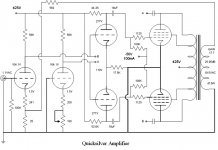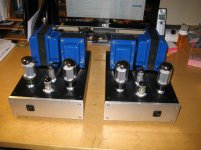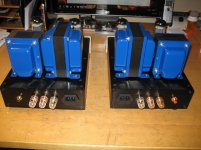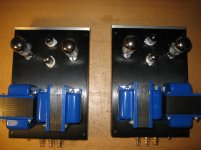...From the schematics it is easy to see why his rectifiers had short life. They were expensive and didn't sound good at all to me...
Rectifiers did not sound good ?
I had a pair of the Quicksilver KT88 amps back in the 1980s. I had to buy a quad of 5AR4s at a time and ended up with stacks of them by keeping a quad or two in my stock. I sold the amp but kept the 5AR4s and they are now worth more than the amp....
I asked Mike Sanders for a schematic and he told me to draw it out myself; so I did.
I asked Mike Sanders for a schematic and he told me to draw it out myself; so I did.
Attachments
Rectifiers did not sound good ?
I think he means the amps.
I had to buy a quad of 5AR4s at a time and ended up with stacks of them by keeping a quad or two in my stock. I sold the amp but kept the 5AR4s and they are now worth more than the amp....
Sad considering running 2 per amp, they should have lasted quite some time with a properly designed PS.
jeff
From the schematics it is easy to see why his rectifiers had short life. They were expensive and didn't sound good at all to me.
I think the Rectifier issue has been beaten to death by now. Everyone knows that first cap was almost 10x too big and gave those rectifiers a real short life. The couplling caps at 400v were not spec'ed high enough. Yes, got it.
Short of the reliability corrections, is this amp worth building? I think so. I like how simple it is. Williamson may sound better (maybe?) but too difficult to get dialed in correctly. This is why I initially asked if there were any real improvements with the tubes I have...but I think I will stay with the original design, and a KT88.
Rectifiers did not sound good ?
The amp didn't sound good, rectifiers just died after few hundred hours.
I think the Rectifier issue has been beaten to death by now. Everyone knows that first cap was almost 10x too big and gave those rectifiers a real short life. The couplling caps at 400v were not spec'ed high enough. Yes, got it.
Short of the reliability corrections, is this amp worth building? I think so. I like how simple it is. Williamson may sound better (maybe?) but too difficult to get dialed in correctly. This is why I initially asked if there were any real improvements with the tubes I have...but I think I will stay with the original design, and a KT88.
You can modify the power supply but will not be enough. That simplicity is the main limitation for its performance. I didn't like it. I would rather build an amp from a classic Acrosound schematics. Like this below. The TO 340 was 5K plate-to-plate.
Attachments
Yes, it's a mistake in fact there is SS rectifier. The QS had the 12FQ7's and a huge input cap as well in the power supply but with tubes! Rubbish anyway...The schematic that 45 posted is an old Michaelson and Austin TVA-???, NOT a Quicksilver.
Craig
Last edited:
Palustris, that is not an 8417, but the KT88 schematic....is the transformer impedance 4200 ohm? What is the tube compliment? Sorry, not familiar with that amp...
The QuickSilver were made with KT88's as well. 4.2K will work good.
Sounds like there are quite a few not impressed wiith the 8417 design.
I am considering the Peter Millet "Universal Input" PCB (need to confim it fits in my chassis). It has a pair of 6SN7 on input (I have quite a few) and looks to be an all in one option (kinda like my Aikido). I could choose the SS or Tube rectifier on PCB...is this a "Much Preferred" Design of the 12AX7/12BH7 Quicksilver design??
See schematic.
Question - (I may just send Pete an email thru ebay where he is selling these PCBs)
Using the 4.2k 60W Edcor Output tranny and a 450V B+, I should still get around 60 watts with this front end, correct?
I could omit input transformers and go Balanced in, correct?
If I go Single Ended in, and Ground the neg input, will it change the amp output if all else the same?
Sorry for the lame questions...
I am considering the Peter Millet "Universal Input" PCB (need to confim it fits in my chassis). It has a pair of 6SN7 on input (I have quite a few) and looks to be an all in one option (kinda like my Aikido). I could choose the SS or Tube rectifier on PCB...is this a "Much Preferred" Design of the 12AX7/12BH7 Quicksilver design??
See schematic.
Question - (I may just send Pete an email thru ebay where he is selling these PCBs)
Using the 4.2k 60W Edcor Output tranny and a 450V B+, I should still get around 60 watts with this front end, correct?
I could omit input transformers and go Balanced in, correct?
If I go Single Ended in, and Ground the neg input, will it change the amp output if all else the same?
Sorry for the lame questions...
Attachments
OK, just realized the transformers do the phase splitting..why would you need one if you had balanced inputs? Am I missing something here?
I also just realized have a 1:1 transformer but it is 600ohm:600ohm (if I remember correctly - a Sescom MI-14?)
Likely not high enough on the input?
I also just realized have a 1:1 transformer but it is 600ohm:600ohm (if I remember correctly - a Sescom MI-14?)
Likely not high enough on the input?
Last edited:
OK, Next question for the 8417
I finally started the build and have the chassis complete...pics later...it will look pretty sweet...
I have a pair of NOS Sylvania 8417....is it worth buying two more Sylvanias ($140) for the other monoblock, or sell the 8417 and buy a quad of KT120?
I finally started the build and have the chassis complete...pics later...it will look pretty sweet...
I have a pair of NOS Sylvania 8417....is it worth buying two more Sylvanias ($140) for the other monoblock, or sell the 8417 and buy a quad of KT120?
Bah! I will stick with the original 8417 design -I even bought a quad of 8417 Sylvania tubes...simple changes: dual bias adjustments, and maybe a 6922 instead of the 12BH7, and some of those nice Russian .22uf/600V mylar coupling caps...Some pics (finally!) Just need to solder everything together...looking good so far...
Attachments
Hello all, I have a quick question - these 8417 are to be biased at 100ma (50ma each tube). I am planning separate bias pots and meter points per 8417 output tube. Does the 50k bias pot have this current running through it? Reason I am asking I am trying to size the pot (1/4 watt? 1/2 watt 2 watt?). If I do the math, I should have around (60V - 15V) = 45V across the 50k pot so 45*45/ 50,000=.04 watts...but if the entire 50ma current goes through the 50k pot, we are talking a lot of wattage
The ones I normally see for fixed bias are usually only 1/4 watt.
The ones I normally see for fixed bias are usually only 1/4 watt.
Last edited:
I use 2W locking pots for bias, usually ETI purchased from mouser. Search on RV4LYSA503A at mouser.com and you will get the 50K locking pot. Only the bias currrent of nearly a mA flows through this pot.
Conservatively rated and reliable, I have never had a RV4LYSA series pot fail on me. (Made also by Ohmite and CTS)
I would recommend a lower value pot frankly of 5K or 10K with more current flowing through it. This will make the bias less prone to changing due to grid current, for the same reason adhere to the recommendations about max grid circuit resistance for the 8417.
Conservatively rated and reliable, I have never had a RV4LYSA series pot fail on me. (Made also by Ohmite and CTS)
I would recommend a lower value pot frankly of 5K or 10K with more current flowing through it. This will make the bias less prone to changing due to grid current, for the same reason adhere to the recommendations about max grid circuit resistance for the 8417.
- Status
- This old topic is closed. If you want to reopen this topic, contact a moderator using the "Report Post" button.
- Home
- Amplifiers
- Tubes / Valves
- Quicksilver 8417 Design - Stay with it or modify?



